Wooden handrails are often used in homes and other buildings to provide support and stability while climbing stairs. Over time, these handrails can become dirty and even sticky due to the accumulation of dust, oils from hands, and other debris.
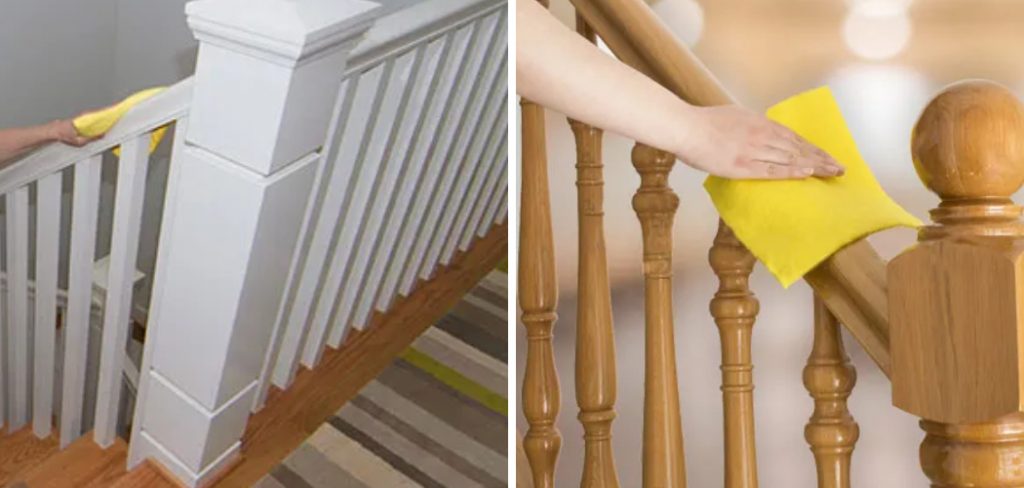
Cleaning wooden handrails not only keeps them looking good but also helps to maintain their durability. In this guide, we will discuss how to clean wooden handrails effectively.
Gather Materials
Before you start cleaning your wooden handrails, it’s important to gather all the necessary materials. This will not only save you time and effort but also ensure that you have everything needed for a thorough cleaning. Here are some of the items you may need:
- Mild Soap or Wood Cleaner: Choose a gentle soap or wood cleaner that won’t damage the wooden surface.
- Warm Water: This will be used to mix with the soap or cleaner.
- Microfiber Cloth or Soft Brush: These tools are gentle enough not to scratch the wood but effective in removing dirt and grime.
- Bucket: Use a bucket to mix your cleaning solution and rinse your cloth/brush.
- Soft Towel: You’ll need this to dry off the handrails after cleaning.
- Furniture Polish or Wood Wax: This is optional but can help restore shine and protect the wood surface. Make sure to choose a polish specifically designed for wooden surfaces.
12 Steps on How to Clean Wooden Handrails
Step 1: Remove Dust and Debris
The first step in cleaning wooden handrails is to remove any loose dust and debris. You can use a microfiber cloth or soft brush to gently sweep the surface of the handrails. Make sure to cover all areas, including corners and crevices.
Step 2: Mix Cleaning Solution
Mix warm water with a mild soap or wood cleaner in a bucket. Follow the instructions on the product label for proper dilution. If using soap, make sure to use only a small amount, as too much can leave a residue.
Step 3: Dip Cloth or Brush into Solution
Dip your microfiber cloth or soft brush into the cleaning solution and wring out any excess water. You want your cloth/brush to be damp but not dripping wet. As a general rule, it’s better to start with a less concentrated solution and add more if needed.
Step 4: Wipe Down Handrails
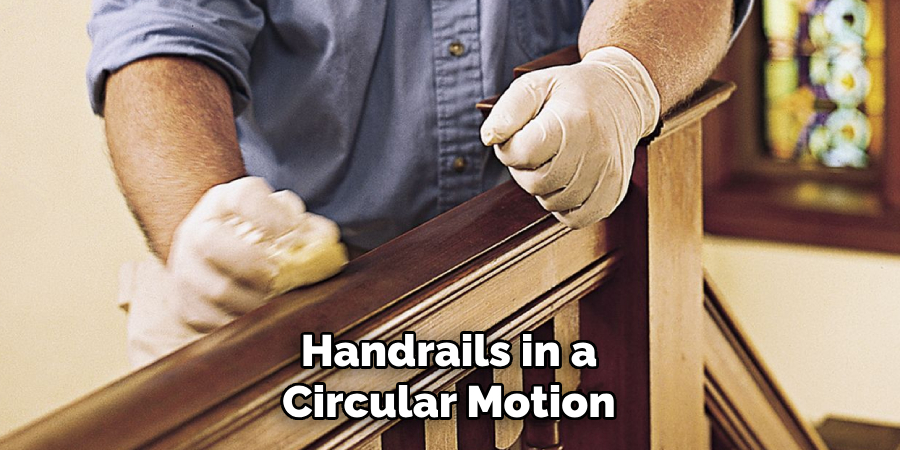
Using your damp cloth or brush, wipe down the handrails in a circular motion. Work your way from top to bottom, covering both sides of the handrail. Make sure to pay extra attention to any sticky spots or areas with visible dirt.
Step 5: Rinse Cloth/Brush
As you clean, your clothes or brush may become dirty. Make sure to rinse it in the bucket of clean water and wring out any excess before continuing. Soiled cleaning tools can leave streaks or spread dirt, so it’s essential to keep them clean.
Step 6: Rinse Handrails
Once you have finished wiping down the handrails, use a clean, damp cloth to remove any soap residue. This will prevent build-up and ensure that your handrails are completely clean. If needed, you can use a second clean cloth to dry the handrails.
Step 7: Dry Handrails
Using a soft towel, dry off the handrails thoroughly. Make sure to remove any excess moisture, as damp wood can warp or rot over time. You may also want to run your hand over the surface of the handrail to check for any missed spots. If necessary, repeat steps 4-6 until the handrails are completely clean.
Step 8: Inspect for Damage
While cleaning your handrails, it’s a good idea to inspect them for any signs of damage. Look for cracks, splinters, or areas where the finish may have worn off. Addressing these issues early on can prevent further damage and save you from having to replace the handrails in the future.
Step 9: Apply Furniture Polish or Wood Wax (Optional)
If your wooden handrails are looking dull or dry, you may want to apply a furniture polish or wood wax. These products can help restore shine and protect the wood surface from everyday wear and tear. Make sure to choose a product specifically designed for wooden surfaces and follow the instructions on the label.

Step 10: Clean Handrails Regularly
To keep your wooden handrails looking their best, it’s essential to clean them regularly. How often you clean will depend on how much use your handrails get, but aim for at least once a month. This will prevent dirt and grime from building up and make the cleaning process more manageable.
Step 11: Use Protective Measures
To further protect your handrails, you may want to consider using protective measures such as adding carpet or rubber stair treads. These can help prevent scratches and reduce wear on your wooden handrails.
Step 12: Consider Refinishing
If your wooden handrails are looking worn and faded, you may want to consider refinishing them. This involves stripping off the old finish and applying a new one. Refinishing can help restore the appearance of your handrails and also provide added protection against dirt and grime.
Cleaning wooden handrails is an essential part of maintaining their appearance and durability. With the right materials and techniques, it’s a simple task that can be done regularly to keep your handrails looking their best.
Remember to inspect for damage and address any issues promptly, and consider using protective measures and refinishing when needed. By following these steps, you can ensure that your wooden handrails stay clean and in top condition for years to come.
9 Safety Measures to Keep in Mind when Cleaning Wooden Handrails
Cleaning wooden handrails can be a straightforward task, but it’s essential to keep safety in mind. Here are nine measures you should take to ensure your safety and the safety of those around you while cleaning wooden handrails:
1) Wear Gloves
When handling cleaning products, it’s always best to wear protective gloves to prevent skin irritation or chemical burns. And if you’re using a heavy-duty cleaning agent, make sure to wear gloves that can withstand its strength.
2) Protect Your Eyes
In case of any splashes or spills, it’s crucial to wear protective eyewear to protect your eyes. This is especially true if you’re using strong chemicals or working in an area with poor ventilation. For example, with gloves, make sure your eyewear is suitable for the product you’re using.
3) Use a Sturdy Ladder
If your handrails are located in an area that requires a ladder to reach, make sure to use a sturdy one. It’s essential to have proper footing and not overextend yourself while cleaning. If possible, have someone hold the ladder for added stability.
4) Keep the Cleaning Area Clear
Before you start cleaning, make sure to remove any obstacles or objects that may get in your way. This includes rugs, furniture, and other items that could cause a tripping hazard or interfere with your cleaning process.
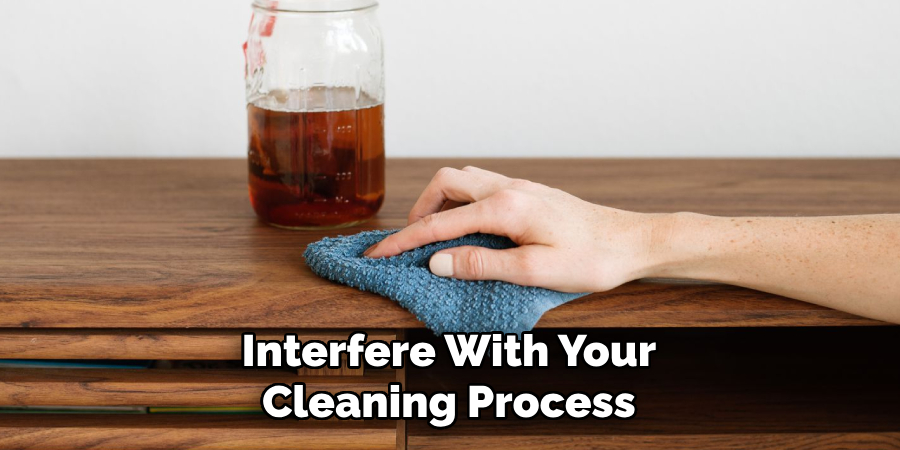
5) Ventilate the Area
If you’re using any strong cleaning products, it’s essential to have proper ventilation. Open windows and doors or use fans to circulate fresh air while you work. This will prevent any harmful fumes from building up in the cleaning area.
6) Read Labels and Follow Instructions
When using cleaning products, always read the labels carefully and follow the instructions provided. Some products may require specific dilution ratios or application methods, so make sure to follow them for optimal results and safety.
7) Don’t Mix Cleaning Products
Mixing different cleaning products can be dangerous as certain combinations can create toxic fumes or chemical reactions. Stick to one product at a time and make sure it’s fully rinsed off before using another one.
8) Store Products Safely
When you’re done cleaning, make sure to store any leftover products in a safe place away from children and pets. Keep them in their original packaging with the labels intact for future use. With strong chemicals, it’s always better to be safe than sorry.
9) Clean Up Spills Immediately
In case of any spills or accidents while cleaning, make sure to clean them up immediately. This will prevent any slips or falls and also avoid damaging your flooring or other surfaces. Use the appropriate cleaning method for spilled products and dispose of any contaminated materials safely.
Cleaning wooden handrails can be a simple and satisfying task. By following these safety measures on how to clean wooden handrails, you can ensure that the process is not only effective but also safe for yourself and those around you. Always prioritize safety when handling cleaning products and equipment to prevent accidents or injuries. Remember to also take breaks as needed and stay hydrated while working.
8 Things to Avoid when Cleaning Wooden Handrails
While cleaning wooden handrails can be a simple and straightforward task, there are a few things you should avoid to ensure the best results. Here are eight common mistakes people make when cleaning wooden handrails:
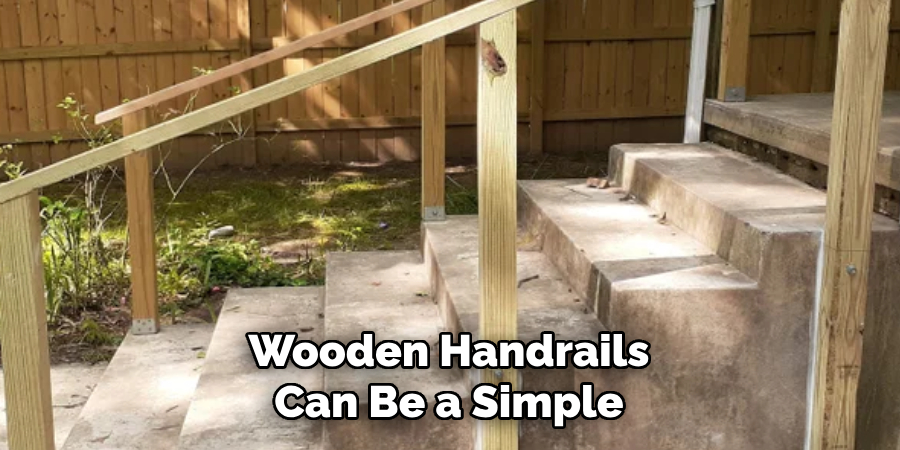
1) Using Abrasive Materials
Avoid using any abrasive materials such as steel wool or harsh scrubbing brushes on your wooden handrails. These can cause scratches and damage to the surface of the wood, making it more susceptible to dirt buildup and wear.
2) Using Excessive Water
Wood is a porous material, so excessive moisture can cause it to warp or even rot over time. When cleaning wooden handrails, make sure not to use too much water and promptly dry them off after cleaning.
3) Using Harsh Chemicals
While some cleaning products may be effective on other surfaces, they can be damaging to wood. Avoid using harsh chemicals or bleach-based cleaners on your wooden handrails as they can strip off the finish and cause discoloration.
4) Neglecting Regular Cleaning
By regularly cleaning your wooden handrails, you can prevent dirt and grime buildup, making the task more manageable in the long run. Neglecting to clean them regularly can lead to tougher stains that may require harsher methods for removal.
5) Not Checking for Damage
Before cleaning your handrails, it’s essential to check for any damage, such as cracks or loose parts. Ignoring these issues could lead to further damage and compromise the safety and stability of your handrails.
6) Leaving Cleaning Products to Sit
Some cleaning products may require a certain amount of time to sit before rinsing them off. However, leaving them on for too long can cause damage to the wood or affect its finish. Make sure to follow instructions carefully and remove the product promptly after the recommended time.
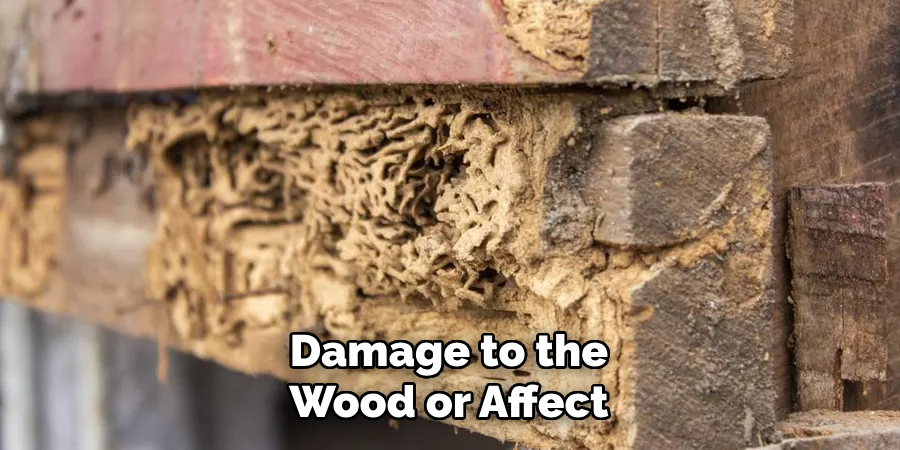
7) Using the Wrong Cleaning Method
Different types of wood may require different cleaning methods, so it’s essential to do your research beforehand. For example, hardwoods may need a gentler approach than softwoods. Using the wrong method can damage the wood and make it harder to clean in the future.
8) Not Protecting Your Hands
While gloves are essential for protecting your hands from harsh cleaning products, they can also prevent damage to the wood. Oils and dirt from your skin can transfer onto the handrail, potentially causing discoloration over time. Make sure to wear gloves while cleaning wooden handrails to avoid this issue.
By avoiding these common mistakes, you can keep your wooden handrails clean and in good condition for years to come. Remember to always prioritize safety and use the proper techniques and products for the best results. With regular cleaning and maintenance, your wooden handrails will continue to look beautiful and serve their purpose effectively.
8 Additional Tips for Cleaning Wooden Handrails
In addition to avoiding common mistakes, here are eight additional tips to make your wooden handrail cleaning process even more effective:
1) Start from the Top
When cleaning a staircase with multiple handrails, start from the top and work your way down. This will prevent any dirt or debris from falling onto already cleaned areas. Then, go back and clean the lower handrails.
2) Use a Soft Cloth
Instead of harsh scrubbing brushes or sponges, opt for a soft cloth like microfiber to clean your wooden handrails. This will prevent any scratches while effectively removing dirt and grime. Like gloves, make sure to use a clean cloth for each handrail to avoid transferring dirt and oils.
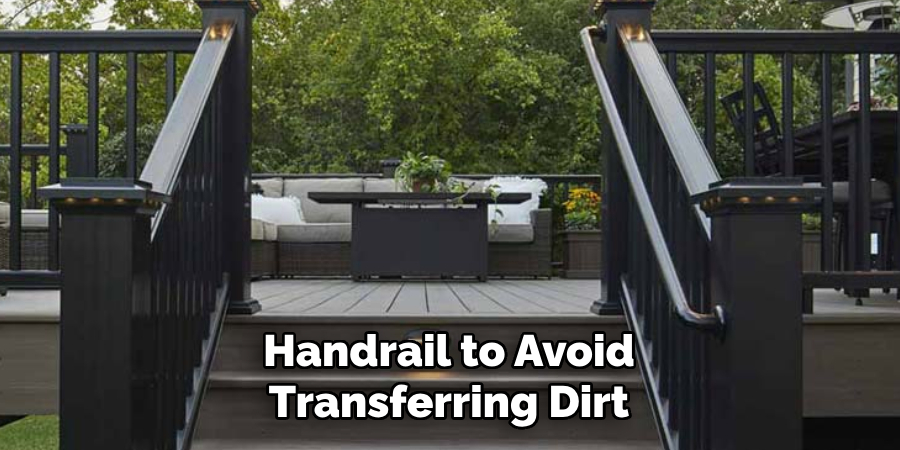
3) Use Natural Cleaning Solutions
If you prefer to use natural cleaning solutions, try mixing equal parts of vinegar and water in a spray bottle. This solution can effectively remove dirt and grime without damaging the wood or affecting its finish.
4) Don’t Forget the Corners
When cleaning your handrails, don’t forget to pay extra attention to the corners and crevices where dirt and grime can build up. Use a toothbrush or cotton swab to reach these areas effectively. Soaking the wooden handrails beforehand can also help loosen any stuck-on dirt in these hard-to-reach spots.
5) Sanding for Tough Stains
For tough stains or deep discoloration on your wooden handrails, sanding may be necessary. Use fine-grit sandpaper and gently buff out the stain. Be sure to follow up with a coat of finish to protect the wood.
6) Choose the Right Finish
When it’s time to apply a finish on your wooden handrails, make sure to choose the right one for the type of wood you have. Different finishes can give different looks and levels of protection. Consult with a professional or do thorough research before making a decision.
7) Regularly Inspect and Maintain
Apart from regular cleaning, it’s important to regularly inspect your wooden handrails for any signs of damage or wear. This can help you catch any issues early on and prevent further damage. Additionally, maintaining the finish with occasional touch-ups can help keep the wood looking its best.
8) Consider Professional Cleaning
If your wooden handrails are heavily stained or damaged, it may be best to seek professional cleaning services. They have the experience and tools necessary to effectively clean and restore wooden handrails without causing any damage.
By following these tips on how to clean wooden handrails, you can keep your wooden handrails looking clean, beautiful, and in good condition for years to come. Remember to always prioritize safety and use the proper techniques and products for the best results. With regular cleaning and maintenance, your wooden handrails will continue to serve their purpose effectively and add charm to your home.
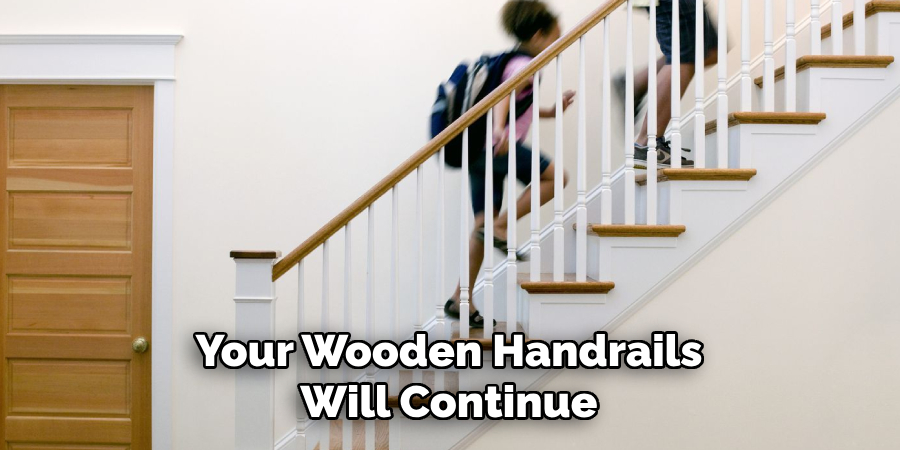
Frequently Asked Questions
Can I Use a Pressure Washer to Clean My Wooden Handrails?
It’s not recommended, as the high-pressure water can damage the wood and its finish. Stick to gentle cleaning methods for wooden handrails.
How Often Should I Clean My Wooden Handrails?
It depends on the amount of traffic and use your handrails receive. Generally, it’s recommended to clean wooden handrails at least once every few weeks or whenever they appear dirty.
Can I Use Any Cleaning Product on My Wooden Handrails?
No, make sure to research and choose products specifically made for cleaning wood. Harsh chemicals or abrasive cleaners can damage the wood and its finish.
Can I Use Oil to Clean My Wooden Handrails?
Some oils, such as linseed oil, can be used to clean and protect wooden handrails. However, make sure to research and follow instructions carefully, as using too much can cause a slippery surface.
How Do I Know If My Wooden Handrails Need to Be Refinished?
If the finish on your wooden handrails is worn out or damaged, it’s time for a new coat. You can also test by sprinkling some water onto the handrail – if the water beads up and sits on top, the finish is still effective.
Conclusion
Cleaning wooden handrails may seem like a daunting task, but with the right techniques and products, it can be done easily. Avoiding common mistakes and following these additional tips on how to clean wooden handrails can help keep your wooden handrails in good condition for years to come.
Remember to prioritize safety, use gentle methods and products, and regularly maintain your handrails for the best results. With proper care, your wooden handrails will continue to add charm and functionality to your home. Remember, a little effort now can save you from the hassle of replacing or repairing your handrails in the future.
About the Author
Adrian Green, a lifelong woodworking enthusiast, shares his passion for the craft through The Woodenify Blog. With a foundation built on years of hands-on experience in his father’s woodworking shop, Adrian is dedicated to helping others learn and grow in the world of DIY woodworking. His approach to woodworking combines creativity, practicality, and a deep appreciation for the art of building with your own hands. Through his blog, he inspires individuals of all skill levels to embark on their own woodworking journeys, creating beautiful, functional pieces of furniture and décor.
Professional Focus
- Specializes in DIY woodworking projects, from furniture to home décor.
- Provides step-by-step guides and practical tutorials for woodworkers of all skill levels.
- Dedicated to helping readers build confidence and skill through easy-to-follow instructions and tips.
- Passionate about fostering a community of makers who can share, learn, and grow together.
Education History
- University of Craft and Design – Bachelor of Fine Arts (BFA) in Woodworking and Furniture Design
- Woodworking Apprenticeships – Extensive hands-on training with skilled craftsmen to refine carpentry and furniture making techniques.
- Online Courses & Masterclasses – Continued education in advanced woodworking techniques, design principles, and specialized tools
Expertise:
- DIY woodworking, carpentry, furniture making, and home décor projects.
- Creating accessible tutorials and guides for beginner to advanced woodworkers.
- Sharing the joys and satisfaction of woodworking, from raw materials to finished products.
